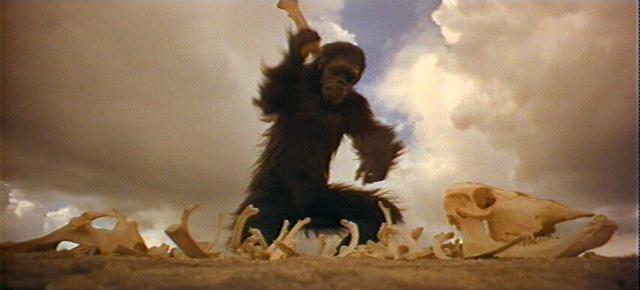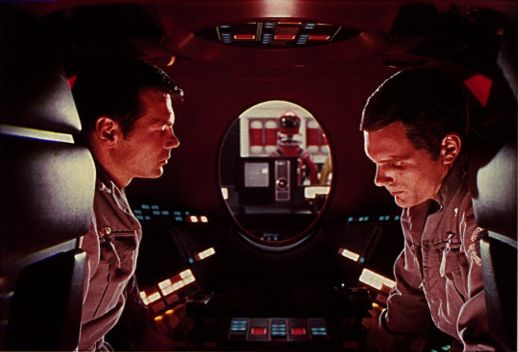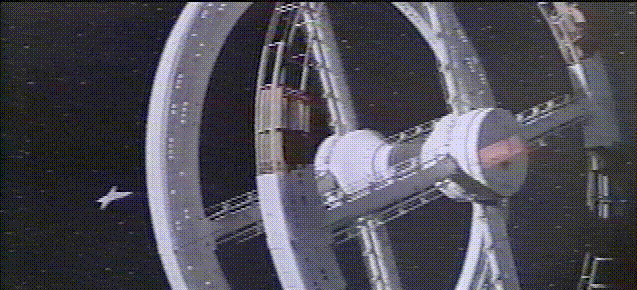|
DVD Review
2001: A Space Odyssey (1968)
Directed by
Stanley Kubrick
Writing credits
Arthur C. Clarke
Stanley Kubrick
|
 |
| I remember it was a Sunday afternoon showing. We went to Frandor, which is reportedly one of the first malls to
ever exist. Of course, by 1968 it was showing its age, but I didn't care - we were going downtown to see a movie.
It started with a long section with some apes standing around, scratching each other, and hooting. When they fought
my then 3-year old sister climbed out of her seat and hid under it. I think she was there for the rest of the movie.
I made it up to the journey "through space and time," but was freaked out by the ending. |
 |
|

|
Now, 32 years later, it's the future and I own the DVD. For the past week I've been able to relax after work by
watching the space station docking scene. With the imperial air of Richard Strauss's "Blue Danube Waltz"
for wallpaper, the Pan Am shuttle performs a weightless ballet with the partially constructed space station ("Did
you see the work on the new section?"). Even with 32 years of space movies, including "Star Wars"
and re-runs of "Star Trek," "Star Trek: The Next Generation," and "Star Trek the next
degerneration", I'm still amazed by this film. It somehow can be so dated, and simultaneously remind you of
the future.
Perhaps, in one way, 1968 was a lot closer to the moon than we are now. Then, one year in the future Man would
be walking on the moon. Now, it's been about 25 years since the last moonshot, and space shuttle time doesn't even
appear on the TV. On the other hand, in 2001 space shuttles will be so humdrum that they'll be run by corporations
instead of governments. |
| 2001 is clearly stuck in 1968. The company Pan Am, who flies the shuttle in the movie, doesn't exist anymore.
Also, the Bell visi-phone is the product of a company long since dispersed. When the scene shows Dr. Floyd
consuming his space food in the form of liquid peas and corn probably only children of the 60's can really identify
- since then solid food in space has been OK. Sure, I can allow the hardwired LED readout in the Jupiter mission
- who could have guessed the invention of LCDs? And the way-too-long journey through space and time looks really
clumsy next to today's computer graphics. But the real fingerprint of 1968 is the theme of the movie: revolution
and change. |
|

|
In the beginning the advancement is the discovery of tools and weapons. Spurred on by the Monolith a pre-human
learns that a bone can kill for food, or for profit. Later, humans have landed on the moon, but the Monolith urges
us on to Jupiter. The timeline is important. While it takes millions of years to advance from caveman to civilization,
it takes only 18 months to move from the moon to Jupiter. Clark and Kubrick are saying that change is coming faster
and faster, and in order to survive we must be able to cope more quickly. Perhaps the fatal flaw in the movie is
the belief that humans can extend themselves with tools. The bone, the shuttle, the space station, the Jupiter
ship, and even HAL are all extensions of humans. But the deep secret is the alien monolith on the moon. Given this
secret is HAL driven mad, or is he merely pushed to evolve much as the early humans did? In the end Dave learns
that he must depend on his humanness to evolve and leaves all his extensions behind, including HAL and the spaceship. |
| Let's talk about the technical aspects of this DVD. The first 10 times I watched the docking scene I was just amazed
at the clarity of the image, and the beauty of the composition. After a while I noticed that during fade-in or
fade-out the screen would become pixilated. I searched my DVD player's menus and found a setting for "Black
Mode." It was set for normal, so I changed it to enhanced. Don't ask me what this is supposed to do, but I
don't notice the pixilation anymore. |
| |
 |
|

|
The design from 2001 was supposed to be totally based on 1968 projections of what man's efforts in space would
really be like. Because of this realism Kubrick has properly omitted the soundtrack from shots that occur in the
inky void of space. You immediately have to contrast this with the roaring X-wing fighters from "Star Wars."
Lucas made no bones about trying to be realistic. "Star Wars" was an action film, and the spaceships
could have equally well been race cars or fighter planes. But the total silence while Frank flails in his death
throes or while the moon bus travels over the surface of Luna only enhances the feeling that man is currently alone
in the universe, and sets up a tension for the future contact. |
Not all the space scenes are silent, and when I hear the "Blue Danube Waltz" during the two portions
of the trip from the earth to the moon, I can't help contrasting this movie with some sort of imperial propaganda
movie created by the Nazis (or even the US) in the 30's. The zeppelin would be filling up with passengers for a
tour of the world. Important people filled with enthusiasm for the future would be invited to see the power and
vision of a country that could create such a technological wonder. The other selections for the soundtrack are
equally apropos. The 2nd and 3rd audio tracks are used for French and Spanish, and it comes with subtitles for
English, Spanish, and French.
On the DVD it advertises an interview with Arthur C. Clark. This is somewhat misleading. Actually, it's a speech
with a sort of question and answer period, and he gave it 32 years ago to a small luncheon party as a publicity
event for the release of the movie. It's not a particularly insightful speech, and most of the people in the room
haven't even yet seen the movie. I was hoping to hear some of his comments on the creation of this movie, and what
he thought of the result, but I didn't find that on this disk. |
Plot Outline:
Mankind finds a mysterious, obviously artificial, artifact buried on the moon and, with the intelligent
computer HAL, sets off on a quest. Also Known As: Journey Beyond the Stars (1967) (USA: working title)
Cast overview, first billed only:
Keir Dullea David Bowman
Gary Lockwood Frank Poole
William Sylvester Dr. Heywood R. Floyd
Daniel Richter (I) Moonwatcher
Leonard Rossiter Smyslov
Margaret Tyzack Elena
Robert Beatty (I) Dr. Halvorsen
Sean Sullivan (I) Michaels
Douglas Rain HAL 9000
Frank Miller (I) Mission Controller
Bill Weston
Ed Bishop (I) Lunar shuttle captain
Glenn Beck
Alan Gifford Poole's Father
Ann Gillis (I)
|
DVD Stats:
o Color, Closed-captioned, Dolby, Widescreen, AC-3
o Theatrical trailer(s)
o Interview with co-screenwriter Arthur C. Clarke
o Widescreen letterbox format
Run Time: 139 minutes
|





